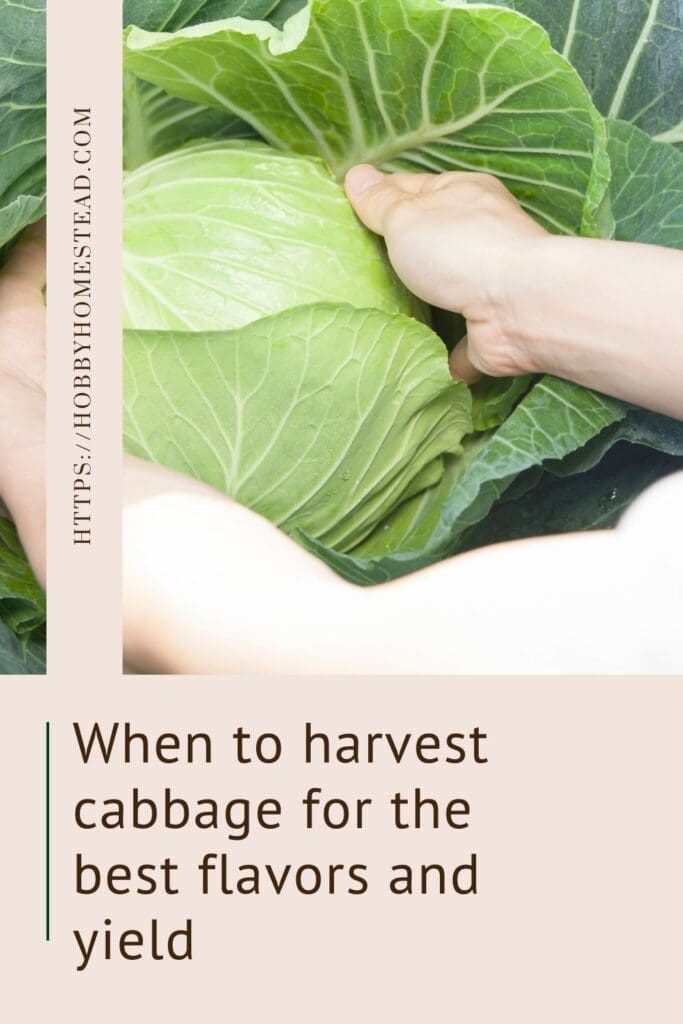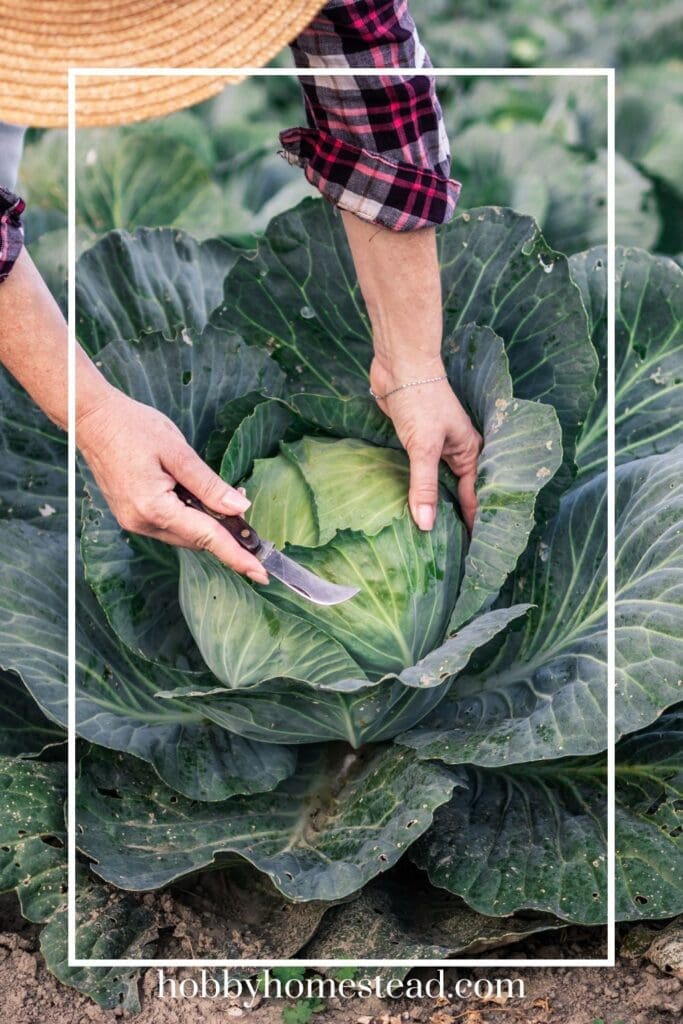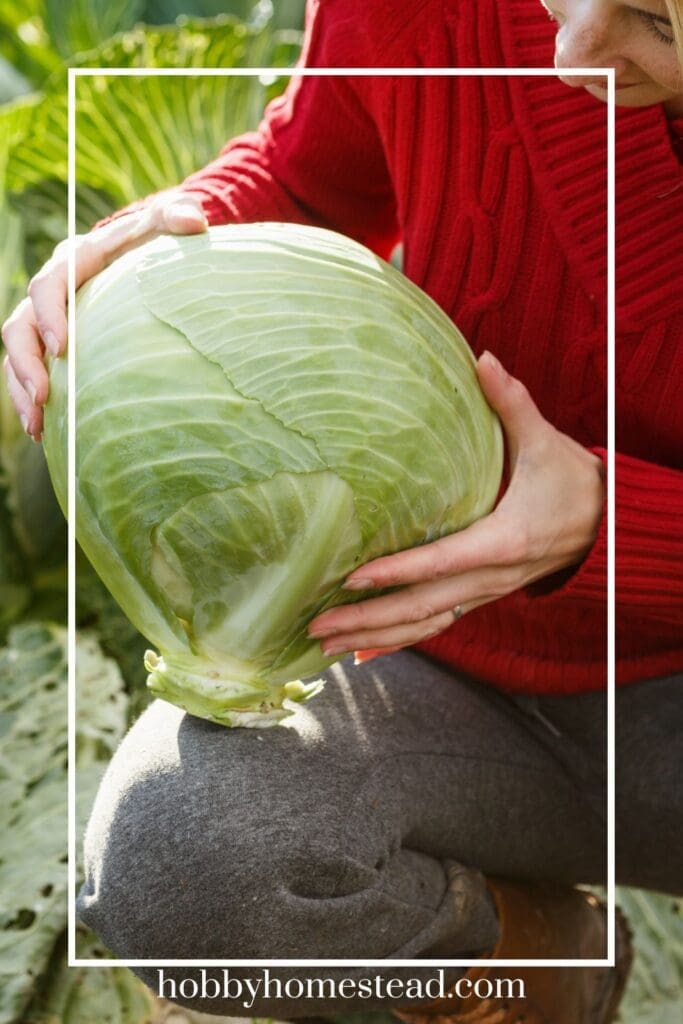When to Harvest Cabbage for the Best Flavors and Yield isn’t just a question of dates. It’s about recognizing the right signs in your garden. Timing your harvest well means enjoying tender, crisp cabbage with maximum flavor and getting the most out of every head.
At our house, we Love our cabbage.
Growing cabbage in your vegetable garden is a real treat, allowing you to enjoy fresh, flavorful heads at their very best. These hardy plants develop dense, tightly packed heads filled with layers of crisp, sweet leaves perfect for eating raw, cooking, or fermenting.
While cabbage is generally easy to grow, timing your harvest correctly is crucial. Wait too long and the heads may split, but pick too early and you’ll miss out on the full, satisfying crop.
Have you ever walked out to the garden and wondered, “Is this cabbage ready yet?” You’re not alone. Figuring out when to harvest cabbage for the best flavors and yield can be tricky—but once you learn what to look for, it becomes second nature.

🥬 When to Harvest Cabbage for the Best Flavors and Yield
Harvesting cabbage at the right time can make the difference between a crisp, flavorful head and one that’s bland or past its prime. Whether you’re growing cabbage for slaws, kraut, or storage, knowing exactly when to harvest is key to maximizing flavor, yield, and longevity.
Why Timing Matters
When cabbage is harvested at peak maturity, it has a sweet, mild flavor and a tender but crisp texture. Pick it too early, and you’ll end up with underdeveloped heads and lower yields.
Leave it too long, and the heads can split, turn bitter, or become tough and woody. Especially in hot weather or after heavy rains.
The right timing also means longer storage, fewer pests, and better nutrition in every bite.
📚 Start with the Variety
Not all cabbage matures on the same schedule. Early-season varieties might be ready in 60–70 days, while others take 100 days or more. Check your seed packet or plant tag to know the expected days to maturity, and make note of the target size and head shape.
- Green cabbage typically forms dense, round heads
- Red cabbage holds its firmness longer and develops deeper flavor as it matures
- Savoy cabbage has looser, ruffled leaves and can be more forgiving
- Napa cabbage is softer and should be harvested sooner for freshness
🥬 Types of Cabbage: How to Identify and Harvest Each One
When it comes to harvesting cabbage for the best flavor and yield, knowing which type you’re growing makes a big difference. Here’s how to tell cabbage varieties apart and the best time to harvest each one based on appearance, firmness, and growing habits.
🟢 Green Cabbage: Classic Round Head with Tight Leaves
Green cabbage is the most common variety, known for its smooth, tightly wrapped leaves and round, compact shape.
- Look for. Pale to medium green color, 4–10 inch diameter heads
- Best harvest time. When the head is firm and dense to the touch
- Harvest tip: Don’t wait too long. Green cabbage is prone to splitting after heavy rains or over-maturity
🔴 Red Cabbage: Vibrant Purple-Red Color and Crisp Texture
Red cabbage resembles green cabbage in shape but stands out with its deep red-purple leaves and slightly peppery flavor.
- Look for. Deep, uniform color and a solid, heavy head
- Best harvest time. Slightly later than green cabbage, but still before the stem begins to crack
- Harvest tip. Holds well in the garden, making it ideal for extended harvests and cold storage
🌀 Savoy Cabbage: Crinkled Leaves with Mild Flavor
Savoy cabbage has a looser structure and heavily crinkled leaves, with a tender texture perfect for cooking.
- Look for. Deep green outer leaves and a moderately compact center
- Best harvest time. When the head has some firmness at the core but not as tight as green cabbage
- Harvest tip. More tolerant of frost, making it ideal for late-season harvests
🧧 Napa Cabbage (Chinese Cabbage): Soft, Elongated Heads
Napa cabbage is popular in stir-fries and kimchi, with a more delicate texture than traditional cabbage types.
- Look for. Elongated, barrel-shaped heads with pale green outer leaves
- Best harvest time. When the head is full and about 10–15 inches long
- Harvest tip. Don’t wait for the head to become very firm. Napa is ready earlier and may bolt in heat
🟢 Conehead or Pointed Cabbage: Sweet and Tender
Pointed cabbage grows in a cone-like shape and has tender, sweet leaves that are great for slaws and light sautés.
- Look for. Tapered, elongated heads with soft green leaves
- Best harvest time. When the head feels full and firm at the base
- Harvest tip. Matures quickly and is prone to splitting—check frequently as the season progresses

Ideal Conditions for Harvesting
The best time to harvest cabbage is in the early morning, when the heads are crisp and cool. Choose a dry day, ideally a few days after rain, to prevent splitting and rot.
Avoid harvesting:
- Right after heavy rain (can cause splitting)
- In the heat of the afternoon (wilting risk)
- When outer leaves show significant yellowing (may be overripe)
Cool, dry weather near the end of the season enhances flavor and improves shelf life.
Signs Your Cabbage Is at Peak Flavor and Yield
Use these indicators to decide when your cabbage is just right:
- The head feels solid and resists compression when gently squeezed
- Outer leaves are vibrant in color and tightly wrapped
- The base of the stem is starting to swell slightly
- There’s no sign of cracking or bolting
- Leaves look fresh. Not limp or dried at the tips
Trust your hands as much as your eyes. A quick squeeze tells you a lot!
Seasonal Harvest Tips
- Spring-planted cabbage. Watch closely as temps rise; heat can trigger splitting or bolting
- Fall-planted cabbage. Often sweeter thanks to light frost; harvest before a hard freeze
- In both cases, check every 2–3 days once you’re within a week of the variety’s expected maturity date
Cabbage Harvesting Tip for All Varieties
No matter which cabbage type you’re growing, the best way to harvest cabbage is by cutting it with a sharp knife just above the outer leaves. Leave the stem and a few leaves in place to encourage regrowth of smaller secondary heads, especially in green and red cabbage types.

Time It Right for the Best Cabbage Ever
To get the best yield and flavor from your cabbage, don’t rely on the calendar alone. Rely on your cabbage’s cues. A firm head, bright outer leaves, and ideal weather conditions all point to the perfect time to harvest. Regular checks will help you avoid disappointment, split heads, or bland taste.
With a little observation and the right timing, your cabbage will go from garden to table at its flavorful best. Perfect for storing it, fermenting it, or enjoying it fresh.


